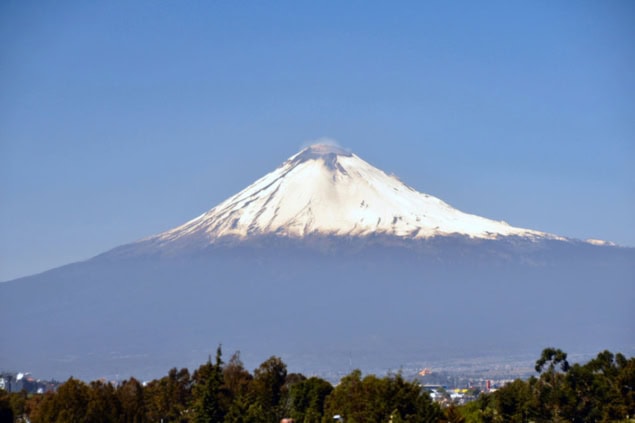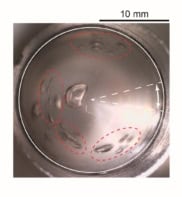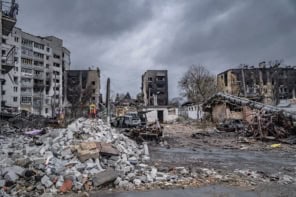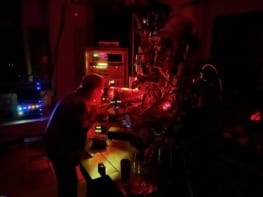James Dacey investigates a plan to use muons to peer inside the throat of Mexico’s famous volcano, Popocatépetl, to help predict the timing and extent of its fiery outbursts

Popocatépetl, meaning “the smoking mountain” in the language of the Aztecs, is a huge active volcano that has always inspired awe and respect among the people living in its shadow. Legend has it that the fiery mountain is the embodiment of the Nahua warrior Popocatépetl, who is still smouldering after the death of his princess lover, Iztaccíhuatl “the white woman”. She gives her name to another snow-topped volcano said to resemble a woman lying on her back, located within the same volcanic belt in central Mexico.
Popocatépetl is still a threat today because more than 25 million people live within 100 km of the volcano, making it the active volcano with the most populous surrounding area in the Americas. The city of Puebla lies 45 km to the east, while 70 km to the north-west is Mexico City – one of the largest metropolitan areas in the world. Fears of an imminent eruption have been rising since 1994, when the volcano released its first ash in 70 years, and the crater has been steaming ever since. In 2000 the volcano had its largest eruption in 1200 years and more than 50,000 people were evacuated from the nearby communities. “Popo”, it seems, has woken up from his geological catnap.
The awakening of Popocatépetl has led to renewed interest among both governing authorities and geoscientists in Mexico
The awakening of Popocatépetl has led to renewed interest in the volcano among both governing authorities and geoscientists in Mexico. They want to build a clearer picture of the innards of this raging man-mountain so they can improve their ability to predict eruptions and the scale of those events. In doing so, they have now turned to astrophysics – and in particular to an imaging technique that begins with particles arriving from outer space.
Hazards aplenty
With a proud conical shape and snowy top, Popocatépetl looks just like a volcano should. But this recently awoken beast, which rises to a height of 5426 m, is grouchy. Fortunately, nobody died in the 2000 eruption, but the volcano is posing a threat to human life. Communities in the immediate vicinity are vulnerable to pyroclastic flows where clouds of hot volcanic fragments race down the slopes of the volcano at staggering speed. If those scorching blizzards don’t get you, then there is also a danger from rapid mud flows known as lahars, caused by melting ice mixing with volcanic debris. A sediment surge of this nature occurred during the eruption of Nevado del Ruiz in Colombia in 1985, killing more than 23,000 people and destroying communities in its wake.
So Popo is a threat to locals – that much is clear. But the fuming giant holds another hazard too – the ash it spews out. This dirty dust causes respiratory problems, can damage buildings and affects air travel. Large plumes of ash and water vapour from Popo forced Puebla’s international airport to close temporarily in separate incidents in December 2014 and February 2015. Similar precautions have been taken in recent years at Mexico City’s airport.
The trouble for the Mexican authorities is that no-one knows for sure when – or how severe – the next eruption will be. So far they have relied on conventional volcano monitoring techniques, which have been deployed at the site since 1989. As an interesting side-story, monitoring of the volcano increased following an early warning of renewed volcanic activity in 1986 when the Mountain Climbers Group from the National Autonomous University of Mexico (UNAM) had reported an increase in the amount of smoke and gases escaping from vents within the summit crater.
Today, the gadgetry – managed by UNAM and the National Centre for the Prevention of Disasters (CENEPRED) – gathers data such as chemical compositions, seismic activity, how the ground is deforming and changes in local gravity readings. The information has enabled geophysicists to build a model of the internal structure of Popo’s volcanic cone with a resolution of several hundred metres, which is only really a fairly crude picture of what is going on inside.
In the footsteps of Luis Alvarez
When a volcano erupts, the amount of material ejected depends largely on how much molten rock has built up within the volcano’s throat within a tubular structure known as the magma conduit. The relationship is not linear: a conduit with a diameter of 100 m results in an eruption rate that is 10 times faster than a 50 m-diameter conduit. To peer inside a volcano and observe changes in the size of these conduits requires an imaging technique with a resolution of the order of tens of metres. Just as importantly, this imaging technique needs to be suitable for a structure as large and inhospitable as a giant active volcano.
At Popocatépetl, a team of scientists and engineers may now have found a creative solution called muon radiography, which exploits the radiation that arrives at the Earth from distant sources in the cosmos. These cosmic rays react with the atmosphere to create showers of muons that rain down on the Earth’s surface. These muons interact very little with air, but they can rapidly lose energy and change direction when interacting with more dense matter. Placing a muon detector beneath or behind a relatively dense object – such as a pyramid or volcano – and monitoring the flux of muons could therefore help reveal the inner structure.
One early adopter of this imaging technique was Luis Alvarez, who won the 1968 Nobel Prize for Physics for his work in particle physics. In the late 1960s he had been looking for unknown structures within the Chephren pyramid in Egypt, one of his many “side projects”, which also included proposing the asteroid-impact theory of how the dinosaurs were wiped out (see “Revisiting the crater of doom”). Sadly, no hidden treasures were revealed in Egypt, but that in itself was an important archaeological discovery, and importantly Alvarez had proved the principle of muon radiography. The technique has since been widely applied. It is, for example, currently being used at the Fukushima Daiichi nuclear power plant in Japan to build a picture of the damage to the sealed-off reactor cores without causing more radiation to be released.

Arturo Menchaca Rocha, a particle physicist at UNAM and one of the principal investigators within the Popocatépetl study, recalls meeting Alvarez and discussing the Chepren project back in the 1970s. The work went on to inspire Menchaca to use muon radiography at the Mesoamerican city of Teotihuacan, 50 km north-east of modern-day Mexico City. Menchaca and his team were interested in the 75 m-tall Pyramid of the Sun, a mysterious sealed structure the interior of which is largely unknown. That 15-year project came to an end in May (see “The pyramid detectives” Physics World December 2014). The final results of that investigation are yet to be published, but it seems that interpretation issues mean that the pyramid’s hidden interior remains largely mysterious.
On the positive side, however, the Teotihuacan project did demonstrate the quality of the detector design by reconstructing several known features of the pyramid’s exterior. Given that success, Menchaca is now turning his gaze from the pyramid to the volcano. He has teamed up with Jaime Urrutia Fucugauchi, a UNAM geophysicist, who had been intrigued by the project at Teotihuacan. Urrutia says the idea for the Popo project was formulated a few years ago when various geophysics groups in Japan and Italy were adopting a similar approach, such as the MuRay group that studies the Stromboli and Vesuvius volcanoes in Italy.
Mountainous challenges ahead
Urrutia points out that although conic volcanoes have a similar shape to pyramids, they bring their own challenges. “Installing the detectors in an active volcano is a difficult problem because it keeps ejecting material including big boulders. So access is difficult and it’s also difficult to keep the instruments working and maintain the power supply,” he says.
Popocatépetl is also much larger than the Sun pyramid, so fewer muons will make it through the mountain than was the case at Teotihuacan. For these reasons, Urrita and Menchaca have designed a detector that is lightweight so it can be transported easily but with a large detecting area to ensure that enough muons are recorded. It will consist of three 9 m2 sheets stacked in parallel with space in between, enabling a 3D reconstruction of particles’ trajectories. Each sheet holds scintillating fluid contained within 30 aligned PVC pipes connected optically to fast light detectors at either end. Using a liquid – rather than plastic – means the researchers can easily replace the scintillating material as required, an important consideration for a long-term project in a volatile environment. Having secured funding for the design project, the scientists say a prototype detector will be ready within three years.
One of the other key differences is that while the pyramid is a static structure, the volcano is a dynamic system and it is these changes the researchers want to image on relatively short timescales, on the order of three months. So on the face of it, it appears as if the Popocatépetl project comes with more challenges than the work at Teotihuacan. Given the challenges of that previous project, then surely Urrita and Menchaca are on a hiding to nothing?
Perhaps not. Studying a volcano does have one big advantage: our existing knowledge. When archaeologists use muon radiography to peer inside a pyramid, they most likely have no idea what lies within, they are feeling their way around in the dark (quite literally in the case of the Sun pyramid, as access to the detector was via a dark, narrow passageway beneath the pyramid). Geophysicists, on the other hand, do have a general idea of a volcano’s structure and know they are looking for the size and location of the magma conduit. “It is more akin to a doctor using X-rays to look inside a human body,” says Menchaca.
Menchaca adds that if the prototype detector is a success, the fully operational system could be in place as early as 2020, so long as they can get the funding for the next stage. “Our detector will become part of the monitoring system, which includes other – more standard – techniques,” he says. In the meantime, he and the team will be making various trips to Popo to select an appropriate site for the detector. Its resting place may end up being something of a trade-off between getting close enough to the peak to maximize the number of muons making it through the rock, but not so close that it gets damaged by eruptions.
Urrita is optimistic about the project. He believes that by mining Popocatépetl for information, his team is following in the footsteps of their Mesoamerican ancestors. The Aztecs, he says, used to climb Popo in order to gather ice from its summit, which they would mix with honey to make a tasty snack. If this audacious muon project goes to plan, this team of intrepid scientists may also live to appreciate the sweet taste of success.



